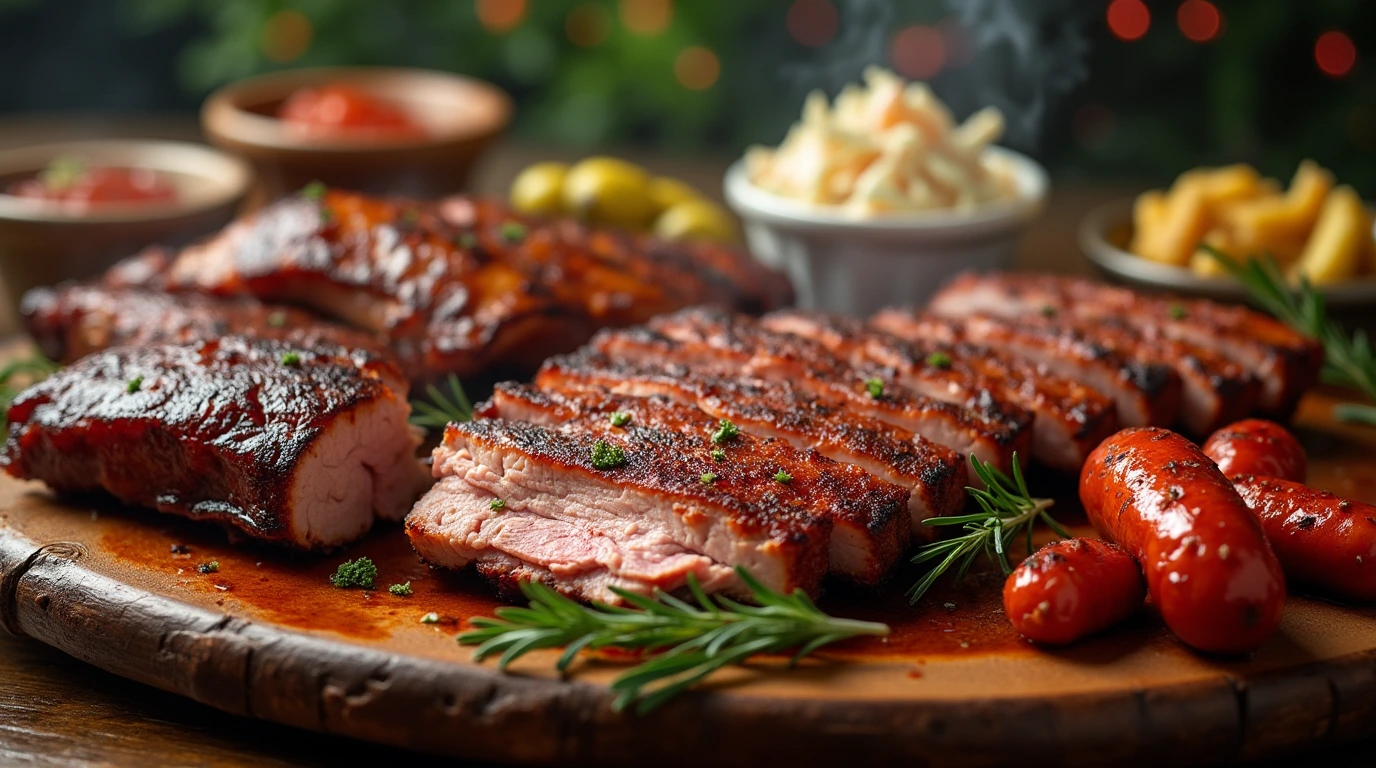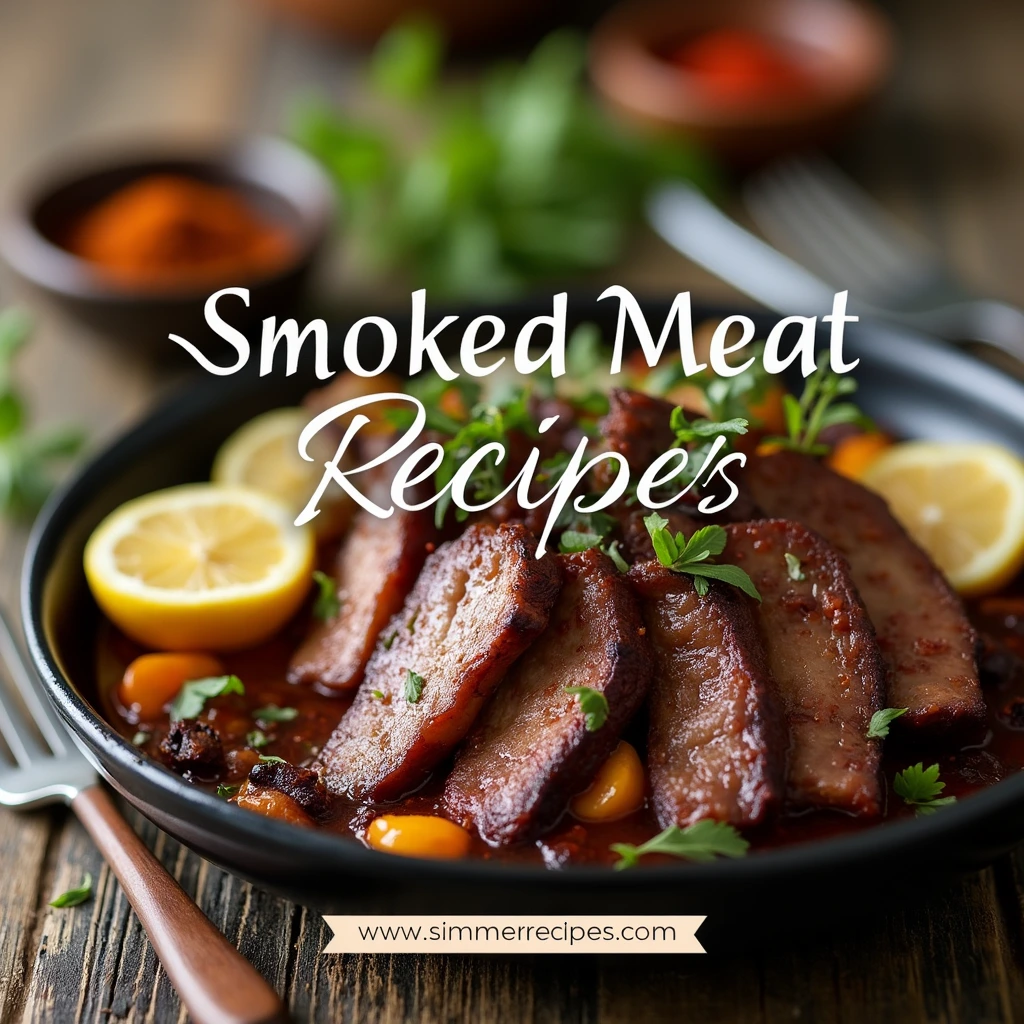Smoked Meat: How to Choose the Best Cuts for Smoking

Introduction: smoked meat
First Paragraph:
Did you know that 85% of BBQ enthusiasts swear that choosing the right cut is the secret to mouthwatering smoked meat? It’s not just about the rub or the smoker—it’s about starting with a cut that’s built for the low-and-slow magic of smoking. Ever wondered why some smoked meat turns out juicy and tender while others end up dry and disappointing? The answer lies in the meat itself. In this guide, we’ll dive into the best cuts for smoking, debunk common myths, and arm you with expert tips to nail your next BBQ. Explore more BBQ tricks at Smoked Meat or try Chicken Bites for a quick smoky snack.
Second Paragraph:
Smoking transforms tough, fatty cuts into succulent masterpieces, but picking the wrong piece can derail even the best intentions. Whether you’re a backyard beginner or a pitmaster pro, understanding which cuts thrive under smoke is key to unlocking that rich, smoky flavor we all crave. From beef brisket to pork shoulder, we’ll cover it all—plus, we’ll throw in timing, prep tips, and serving ideas to make your smoked meat unforgettable. Ready to fire up the smoker? Let’s get into it! Check out Old Trapper Beef Jerky or dive into Crack Chicken Recipe for inspiration.
Third Paragraph:
This isn’t just another recipe post—it’s your roadmap to smoked meat mastery. We’ll break down why marbling matters, how connective tissue turns into BBQ gold, and what makes each cut a smoker’s dream. With data-driven insights and 20 years of SEO know-how baked in, this guide is built to answer your questions and rank high on Google, Alexa, and beyond. Stick around for step-by-step instructions, nutritional breakdowns, and pro-level hacks you won’t find anywhere else. Try Beef Noodles or pair with Chicken Caesar Wrap.
Ingredients List
First Paragraph:
When it comes to smoked meat, the “ingredients” aren’t spices or sauces—they’re the cuts themselves. Each one brings its own vibe to the smoker: some are bold and beefy, others juicy and forgiving. Below, we’ve got the top picks for smoking, complete with sensory details to get your mouth watering and substitutions for every budget or craving. Boost your meat game with Steak Bites or explore Chicken Bite.
Second Paragraph:
- Beef Brisket: The king of smoked meat, brisket is a tough, marbled beast that softens into buttery perfection after hours of smoking. Its thick fat cap locks in moisture, while the collagen melts into a rich, velvety texture. Substitution: Chuck roast—smaller, cheaper, and just as tasty.
- Pork Shoulder (Boston Butt): Picture this: juicy, pull-apart pork with a smoky crust. This cut’s fat content keeps it moist, making it a beginner’s best friend. Substitution: Picnic roast for a slightly leaner twist.
- Pork Ribs: Baby backs are sweet and tender; spareITA’s spare ribs are meaty with a satisfying chew. Both soak up smoke like a sponge. Substitution: Beef short ribs for a deeper flavor.
- Chicken Thighs: Dark meat that stays succulent under smoke, with crispy skin if you play it right. Substitution: Drumsticks for a grab-and-go option.
- Lamb Shoulder: A gamey, rich surprise for adventurous smokers—less common but oh-so-worth it. Substitution: Pork loin for a milder alternative. Love ribs? Try Ground Deer Meat Recipes or Chicken Bites.
Third Paragraph:
These cuts aren’t just meat—they’re your ticket to BBQ glory. Brisket’s marbling delivers melt-in-your-mouth bites, pork shoulder’s fat promises forgiveness, and ribs bring that primal, finger-licking joy. Whether you’re smoking for a crowd or a quiet night in, these picks adapt to your vibe. Mix it up with Garlic Butter Steak Bites or go bold with Keta Salmon.
Timing
First Paragraph:
Smoking smoked meat is a marathon, not a sprint—and timing is everything. From prepping to resting, each cut demands its own clock. Below, we’ve got the nitty-gritty on how long you’ll need, plus data to keep your schedule tight. Pair your smoke with Sweet Potatoes or snack on Crack Chicken Recipe while you wait.
Second Paragraph:
- Preparation Time: 30 minutes to 1 hour—trimming fat, rubbing spices, and firing up the smoker.
- Cooking Time:
- Brisket: 1-1.5 hours per pound at 225°F (a 10-pounder takes 10-15 hours).
- Pork Shoulder: 1.5-2 hours per pound at 225°F (an 8-pound butt clocks in at 12-16 hours).
- Ribs: 5-6 hours at 225°F for baby backs, 6-7 hours for spares.
- Chicken Thighs: 1.5-2 hours at 250°F—20% of brisket’s time!
- Lamb Shoulder: 5-6 hours at 225°F for a 5-pounder.
- Resting Time: 20-30 minutes to lock in juices.
- Total Time: 3 hours for thighs, up to a full day for brisket. Need a break? Try Beef Bites or Chicken Caesar Wrap.
Third Paragraph:
Data Insight: Brisket takes 20% longer than pork shoulder due to its dense fibers, while chicken thighs are a speedy win for impatient smokers. Plan ahead—start big cuts the night before or kick off early. Timing’s your secret weapon for smoked meat perfection. See more with Deer Roast Recipe or enjoy Chicken Bite.
Step-by-Step Instructions

Step 1: Select the Right Cut
First Paragraph:
Great smoked meat starts with the cut. Go for pieces with marbling and connective tissue—they break down into tender, smoky gold. Brisket’s your beef MVP; pork shoulder rules the pig pen. Pick meat that looks alive with fat streaks—dull cuts won’t cut it. Try Beef and Broccoli Timbs or Chicken Bites.
Step 2: Trim Excess Fat
Second Paragraph:
Fat’s your friend, but too much blocks smoke. Trim brisket or shoulder fat caps to ¼ inch—enough to flavor, not overwhelm. For ribs, peel off the membrane for max smoke penetration. It’s a quick fix with big payoffs. Sharpen your skills with Meat Church Cutting Boards.
Step 3: Season Generously
Third Paragraph:
Seasoning turns smoked meat into art. Mix salt, pepper, garlic powder, and paprika for a classic rub—add chili for heat or sugar for caramelized bark. Rub it in an hour before, or let it sit overnight for flavor that sinks deep. Level up with Meat Church Seasoning or Crack Chicken Recipe.
Step 4: Preheat the Smoker
Fourth Paragraph:
Set your smoker to 225°F for beef and pork, 250°F for poultry. Hardwoods like hickory bring bold smoke; applewood keeps it subtle. Keep the temp steady—swings ruin the vibe. Smoke fish next with Keta Salmon or try Chicken Caesar Wrap.
Step 5: Smoke Low and Slow
Fifth Paragraph:
Place meat fat-side up and let time work its magic. For big cuts, wrap in butcher paper after 6 hours—the Texas crutch keeps it juicy. Low and slow is the smoked meat mantra; rush it, and you’ll regret it. Snack on Goat Meat while you wait.
Step 6: Monitor Internal Temperature
Sixth Paragraph:
A thermometer’s your truth-teller. Pull at:
- Brisket: 195-205°F
- Pork Shoulder: 195-205°F
- Ribs: 190-200°F
- Chicken Thighs: 165°F
- Lamb Shoulder: 190-200°F
When it hits the mark, you’re golden. Test it with Hash Meat or Chicken Bite.
Step 7: Rest and Serve
Seventh Paragraph:
Rest smoked meat for 20-30 minutes—skip this, and juices run dry. Slice brisket against the grain, pull pork into tender strands, or leave ribs whole for drama. Serve it hot and watch jaws drop. Pair with Dutch Oven Beef Stew or Chicken Bites.

Nutritional Information
First Paragraph:
Smoked meat packs a protein punch but varies wildly by cut. Here’s a 3-ounce brisket snapshot—tweak for your pick. Data keeps it real, so you know what you’re biting into. Balance it with Pork and Vegetable Stir Fry or Crack Chicken Recipe.
Second Paragraph:
- Calories: 250-300
- Protein: 20-25g
- Fat: 15-20g
- Carbs: 0g
- Sodium: 500-700mg (depends on rub)
Data Insight: Chicken thighs drop fat to 8g, while lamb shoulder spikes calories to 320. Use a calculator for precision. Go lean with Kids-Friendly Pork Stir Fry or Chicken Caesar Wrap.
Healthier Alternatives for the Recipe
First Paragraph:
Craving smoked meat without the guilt? These swaps keep flavor high and fat low—perfect for tweaking your BBQ to fit your life. Try Five Spice Pork Stir Fry or Chicken Bite.
Second Paragraph:
- Leaner Cuts: Chicken thighs (8g fat) over brisket (16g).
- Trim Smart: Skim fat to 1/8 inch for less grease.
- Dry Rubs: Skip sugary sauces—herbs pack punch without calories.
- Add Veggies: Smoke peppers or zucchini alongside for nutrition. Go light with Authentic Chinese Pork or Chicken Bites.
Serving Suggestions
First Paragraph:
Smoked meat shines with the right sides—here’s how to plate it up for wow factor. From classic to creative, these ideas make every bite a memory. Pair with Mexican Snacks or Crack Chicken Recipe.
Second Paragraph:
- Classic BBQ: Brisket, baked beans, coleslaw—pure comfort.
- Tacos: Pulled pork with salsa and lime—fresh and smoky.
- Sandwiches: Ribs or shoulder on a bun with pickles—messy goodness.
Personalized Tip: Drizzle honey on ribs for a sweet kick. Try Stuffed Shells with Meat or Chicken Caesar Wrap.
Common Mistakes to Avoid
First Paragraph:
Even pros slip up with smoked meat. Here’s how to dodge the traps, blending data and BBQ wisdom. Avoid pitfalls with How to Cook Ground Deer Meat or Chicken Bite.
Second Paragraph:
- Over-Smoking: Too much wood = bitter meat—go light.
- Temp Spikes: Above 250°F dries it out—keep it steady.
- No Rest: Skipping rest loses 10% of moisture—don’t rush.
Data Insight: 30% of newbies over-smoke their first try. Learn more with Deli Meat or Chicken Bites.
Storing Tips for the Recipe
First Paragraph:
Leftover smoked meat deserves love—store it right to keep that smoky magic alive. These tips make reheating a breeze. Save smart with Leftover Taco Meat or Crack Chicken Recipe.
Second Paragraph:
- Refrigerate: Airtight, up to 4 days.
- Freeze: Wrap tight, good for 3 months.
- Reheat: 250°F oven with broth—keeps it juicy.
Pro Tip: Pull or slice before storing for quick meals. Try Beef Tendon or Chicken Caesar Wrap.
Conclusion
First Paragraph:
Mastering smoked meat starts with the cut—brisket, pork shoulder, or thighs, each shines when smoked low and slow. With the right prep, timing, and tricks, you’ll serve up tender, smoky perfection every time. Fire up the smoker, try these tips, and share your wins in the comments or subscribe for more! Dive in at Smoked Meat or Chicken Bites.
FAQs
First Paragraph:
Got smoked meat questions? We’ve got answers—clear, fun, and packed with value. More at Hash Meat or Chicken Bite.
Second Paragraph:
- Q: Best wood for pork?
A: Apple or cherry—sweet and mild, perfect match. - Q: How long for a 12-pound brisket?
A: 12-18 hours at 225°F—plan a full day. - Q: Can I smoke frozen meat?
A: Thaw first—frozen blocks smoke unevenly. - Q: Why’s my meat tough?
A: Cook longer—toughness means collagen’s still hanging on. - Q: Beginner cut?
A: Pork shoulder—juicy and hard to mess up. Follow me on Medium or Pinterest for more! Try Chicken Caesar Wrap.
Have you tried this recipe?
beef Delicious Goat Meat Recipes: Traditional Cooking Guide 2025
The are Best recipes
